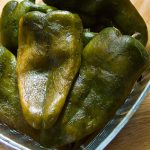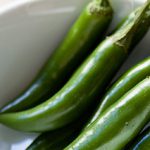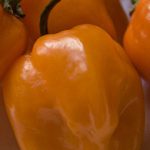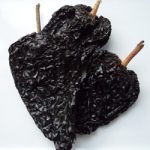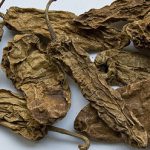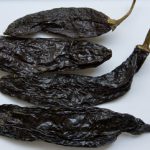Get Over Your Fear of Chiles!
Last week we talked a little about how some people feel that no matter what chile they might use, it will be too hot. I mentioned balance and moderation, but there are a few other things to know before we really get cooking.
The reason chiles are hot? Capsaicin. It’s tasteless and odorless, but is the natural ingredient in chile peppers responsible for the heat factor.
Sometimes the level of capsaicin varies, even in some of the mildest chiles. To prevent the burn from the heat, you can wear rubber gloves (any thickness from medical-type to up-to-the-elbows yellow dishwashing gloves). Be sure if you don’t wear gloves while handling spicy chiles to not touch other body parts or areas of skin, especially the eyes and mouth, or you could end up feeling an uncomfortable burning sensation.
And to combat the heat but still get the flavor that makes each chile unique, remove the seeds and veins, where the capsaicin mainly lies.
Another factor in how you use chiles in the kitchen will be whether you use them in fresh form, roasted or dried. While using fresh chiles is often not as scary for some, a lot of people are apprehensive about using dried chiles. The easiest way to cook with dried chiles is by heating them on a comal or griddle and then soaking them in hot water until they soften enough to be ground up in a food processor or a blender.
You can also remove the veins and seeds from dried chiles either before or after rehydrating them. Whether dried or fresh, just use a sharp knife to scrape out the seeds and remove any thick or stringy veins inside.
This basic guide to a few common chiles should help you navigate with ease.
FRESH CHILES
Poblano
These are large, broad green chiles with a dark green skin. They’re considered to be mild. They can be made into just about anything from sauce to chiles rellenos, and are also great as the “meat” of a vegetarian dish. My favorite way to use them, and one of the most popular recipes on my site, is in a dish called rajas con crema, where the chile is cut into strips and sauteed with onion, butter and Mexican cream (sort of like sour cream, but creamier and milder). The poblanos pictured here have been roasted and the skins removed to prepare them.
Serrano
Serrano are small, green chiles, similar to the jalapeño but with a little bit more heat. They’re considered mild to medium. They’re the most used fresh chile in my kitchen and are a staple. They’re part of the base of most of the green salsas I make at home. They are typically about the size of your finger but they can pack a lot of punch. They’re also great to just slice or dice and add them to scrambled eggs for breakfast or to a traditional dish like this fruity pico de gallo made with jicama.
Habanero
Small with orange skin and flesh, you’ll probably want to handle these peppers with gloves, and a little goes a long way. They’re usually sold fresh but can also be found dried. They’re considered hot to extreme heat. They are not the hottest chile that exists, though; they rank at only about one third of the heat of the ghost pepper (also known as bhut jolokia or naga jolokia) from India. My favorite way to use habaneros is to roast them on a comal or griddle and then use them in a salsa with roasted red tomatoes. Or, they also add some serious kick to the pickled red onion salsa to accompany cochinita pibil.
DRIED CHILES
Ancho
Ancho are dried poblano chiles and are considered to have mild heat. I like to soak these and put them in the food processor to make a paste that I can rub over red meats before grilling, especially cuts such as skirt steak (also known as arrachera). They’re also commonly used in the red sauce for enchiladas because they’re not very spicy, but have a really earthy flavor. A similar chile that can be used as a substitute is the mulato chile.
Chipotle
These are smoked red jalapeños. They can either be dry (usually sold packaged in cellophane and can be a light brown color), or in adobo sauce (cured and preserved with vinegar, tomato sauce or paste, ancho chiles and spices like the kind we use for chipotle mayo). Depending on the size of the dried chipotles, you may also see smaller ones called mora or morita chiles, and those will be more of a reddish-brown color. They’re considered medium heat. My favorite way to use chipotles is in a sauce for a Mexican meatball dish served over rice and beans, called albóndigas.
Pasilla
Pasilla are dried chilaca chiles (mild and similar to poblano but with thinner flesh and skin) and are sometimes also called chile negro. They can have somewhat of a sweet taste and are best used in salsas, mole, soups and stews. Long and skinny in shape, they’re one of the most popular dried chiles in Mexican cuisine and have a very earthy flavor. Pasilla chiles can also be substituted for ancho or mulato chiles in some dishes. My favorite way to use pasilla chiles is as a salsa in a dish called filete de res a la Chiapaneca, a steak dish that comes from the state of Chiapas.
Kenmore
The Kenmore brand represents 100 years of trusted performance, backed by exclusive features and innovations that no other brand can bring to the table. We’re always evolving to ensure day-to-day tasks are taken care of with faster cooking, better cleaning and more living throughout the home.

